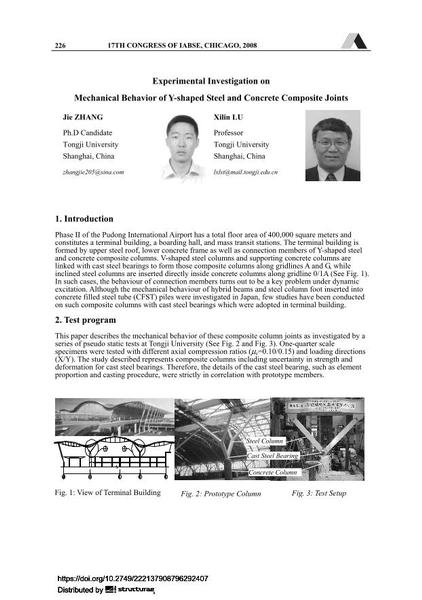Experimental Investigation on Mechanical Behavior of Y-shaped Steel and Concrete Composite Joints

|
|
|||||||||||
Détails bibliographiques
| Auteur(s): |
Jie Zhang
Xilin Lu |
||||
|---|---|---|---|---|---|
| Médium: | papier de conférence | ||||
| Langue(s): | anglais | ||||
| Conférence: | 17th IABSE Congress: Creating and Renewing Urban Structures – Tall Buildings, Bridges and Infrastructure, Chicago, USA, 17-19 September 2008 | ||||
| Publié dans: | IABSE Congress Chicago 2008 | ||||
|
|||||
| Page(s): | 226-227 | ||||
| Nombre total de pages (du PDF): | 7 | ||||
| Année: | 2008 | ||||
| DOI: | 10.2749/222137908796292407 | ||||
| Abstrait: |
Phase II of the Pudong (Shanghai) International Airport terminal building has interior spans of 89m, 18m bay spacing, and 26m height above the top story. Upper steel roof and lower concrete frame are assembled with Y-shaped steel and concrete composite columns. These composite columns were formed by upper V-shaped steel columns, lower concrete columns, and cast steel bearings as a connection. This paper describes the mechanical behaviour of these composite column joints as investigated by a series of pseudo static tests at Tongji University. Two of the parameters that were examined include the axial compression ratio and loading direction. Results showed that damage occurred at the bottom of the steel column because the modulus of elasticity and yield strength were both reduced approximately 10% in the Heat Affected Zone (HAZ) along with higher actual strength of cast steel. Cracking, and even spalling were observed at the top of concrete columns due to concentrated moment applied by upper steel columns. Relevant recommendations were presented for improving concrete confinement. Furthermore, a potential critical section in the cast steel bearings was identified based on the free body diagram, strain measurements and results of numerical analyses. Elastic rotational stiffness of the cast steel bearing was included in the analysis of rotation angle. In addition, it was determined that slip between concrete and encased steel could be ignored because sufficient anchorage length and shear connectors were provided as specified in the Chinese Design Code. |
||||
